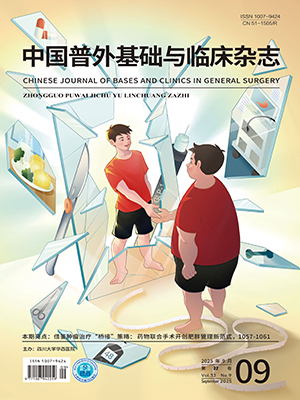| 1. |
Adams WP, Lipschitz AH, Ansari M, et al. Functional donor site morbidity following latissimus dorsi muscle flap transfer. Ann Plast Surg, 2004, 53(1): 6-11.
|
| 2. |
Marín-Gutzke M, Sánchez-Olaso A. Reconstructive surgery in young women with breast cancer. Breast Cancer Res Treat, 2010, 123 Suppl 1: 67-74.
|
| 3. |
Yang CE, Roh TS, Yun IS, et al. Immediate partial breast reconstruction with endoscopic latissimus dorsi muscle flap harvest. Arch Plast Surg, 2014, 41(5): 513-519.
|
| 4. |
Sood R, Easow JM, Konopka G, et al. Latissimus dorsi flap in breast reconstruction: Recent innovations in the workhorse flap. Cancer Control, 2018, 25(1): 1073274817744638. doi: 10.1177/1073274817744638.
|
| 5. |
Berthet G, Faure C, Dammacco MA, et al. Tolerance of latissimus dorsi in immediate breast reconstruction without implant to radiotherapy. J Plast Reconstr Aesthet Surg, 2018, 71(1): 15-20.
|
| 6. |
Winocour S, Tarassoli S, Chu CK, et al. Comparing outcomes of robotically assisted latissimus dorsi harvest to the traditional open approach in breast reconstruction. Plast Reconstr Surg, 2020, 146(6): 1221-1225.
|
| 7. |
Toesca A, Peradze N, Galimberti V, et al. Robotic nipple-sparing mastectomy and immediate breast reconstruction with implant: First report of surgical technique. Ann Surg, 2017, 266(2): e28-e30. doi: 10.1097/SLA.0000000000001397.
|
| 8. |
Lai HW, Chen ST, Tai CM, et al. Robotic- versus endoscopic-assisted nipple-sparing mastectomy with immediate prosthesis breast reconstruction in the management of breast cancer: A case-control comparison study with analysis of clinical outcomes, learning curve, patient-reported aesthetic results, and medical cost. Ann Surg Oncol, 2020, 27(7): 2255-2268.
|
| 9. |
Lai HW, Chen ST, Lin SL, et al. Technique for single axillary incision robotic assisted quadrantectomy and immediate partial breast reconstruction with robotic latissimus dorsi flap harvest for breast cancer: A case report. Medicine (Baltimore), 2018, 97(27): e11373. doi: 10.1097/MD.0000000000011373.
|
| 10. |
Eo PS, Kim H, Lee JS, et al. Robot-assisted latissimus dorsi flap harvest for partial breast reconstruction: comparison with endoscopic and conventional approaches. Aesthet Surg J, 2023, 44(1): 38-46.
|
| 11. |
Missana MC, Pomel C. Endoscopic latissimus dorsi flap harvesting. Am J Surg, 2007, 194(2): 164-169.
|
| 12. |
Losken A, Schaefer TG, Carlson GW, et al. Immediate endoscopic latissimus dorsi flap: risk or benefit in reconstructing partial mastectomy defects. Ann Plast Surg, 2004, 53(1): 1-5.
|
| 13. |
Serra-Renom JM, Serra-Mestre JM, Martinez L, et al. Endoscopic reconstruction of partial mastectomy defects using latissimus dorsi muscle flap without causing scars on the back. Aesthetic Plast Surg, 2013, 37(5): 941-949.
|
| 14. |
Kim DG, Kim JS, Lee JS, et al. The usefulness of endoscopic harvesting of the latissimus dorsi flap for breast reconstruction using a single-port and CO2 gas insufflation technique. Aesthetic Plast Surg, 2021, 45(6): 2681-2690.
|
| 15. |
Iglesias M, Gonzalez-Chapa DR. Endoscopic latissimus dorsi muscle flap for breast reconstruction after skin-sparing total mastectomy: report of 14 cases. Aesthetic Plast Surg, 2013, 37(4): 719-727.
|
| 16. |
Ahmed YS, Abd El Maksoud WM. Combined endoscopy-assisted muscle-sparing latissimus dorsi flap harvesting with lipofilling enhancement as a new volume replacement technique in breast reconstruction. Breast J, 2022, 2022: 7740439. doi: 10.1155/2022/7740439.
|
| 17. |
Liang F, Wen N, Xie Y, et al. Subversion of endoscopic breast reconstruction surgery: nipple-sparing mastectomy and immediate reconstruction with a latissimus dorsi flap/latissimus dorsi flap and implant through a single axillary incision. Ann Surg Open, 2021, 2(3): e082. doi: 10.1097/AS9.0000000000000082.
|
| 18. |
Qiu J, Wen N, Xie Y, et al. Novel technique for endoscopic-assisted nipple-sparing mastectomy and immediate breast reconstruction with endoscopic-assisted latissimus dorsi muscle flap harvest through a single axillary incision: a retrospective cohort study of comparing endoscopic and open surgery. Gland Surg, 2022, 11(8): 1383-1394.
|
| 19. |
Feng Y, Wen N, Liang F, et al. Endoscopic nipple- or skin-sparing mastectomy and immediate breast reconstruction with endoscopic harvesting of the latissimus dorsi flap: A preliminary experience of an innovative technique. Breast J, 2022, 2022: 1373899. doi: 10.1155/2022/1373899.
|
| 20. |
Du Z, Zhou Y, Chen J, et al. Retrospective observational study of breast reconstruction with extended latissimus dorsi flap following skin-sparing mastectomy. Medicine (Baltimore), 2018, 97(31): e10936. doi: 10.1097/MD.0000000000010936.
|
| 21. |
Regnault P. Breast ptosis. Definition and treatment. Clin Plast Surg, 1976, 3(2): 193-203.
|
| 22. |
Dindo D, Demartines N, Clavien PA. Classification of surgical complications: a new proposal with evaluation in a cohort of 6 336 patients and results of a survey. Ann Surg, 2004, 240(2): 205-213.
|
| 23. |
Spear SL, Baker JL Jr. Classification of capsular contracture after prosthetic breast reconstruction. Plast Reconstr Surg, 1995, 96(5): 1119-1124.Spear SL, Baker JL Jr. Classification of capsular contracture after prosthetic breast reconstruction. Plast Reconstr Surg, 1995, 96(5): 1119-1124.
|
| 24. |
Pusic AL, Klassen AF, Scott AM, et al. Development of a new patient-reported outcome measure for breast surgery: the BREAST-Q. Plast Reconstr Surg, 2009, 124(2): 345-353.
|
| 25. |
Nam SB, Oh HC, Choi JY, et al. Volumetric change of the latissimus dorsi muscle after immediate breast reconstruction with an extended latissimus dorsi musculocutaneous flap. Arch Plast Surg, 2019, 46(2): 135-139.
|
| 26. |
Chang HP, Fan KL, Song SY, et al. The traditional versus endoscopic-assisted latissimus dorsi harvest in oncoplastic surgery: A long term comparison of breast volume, aesthetics, and donor site outcomes. Asian J Surg, 2020, 43(12): 1165-1171.
|
| 27. |
Clemens MW, Kronowitz S, Selber JC. Robotic-assisted latissimus dorsi harvest in delayed-immediate breast reconstruction. Semin Plast Surg, 2014, 28(1): 20-25.
|
| 28. |
Houvenaeghel G, El Hajj H, Schmitt A, et al. Robotic-assisted skin sparing mastectomy and immediate reconstruction using latissimus dorsi flap a new effective and safe technique: A comparative study. Surg Oncol, 2020, 35: 406-411.
|




